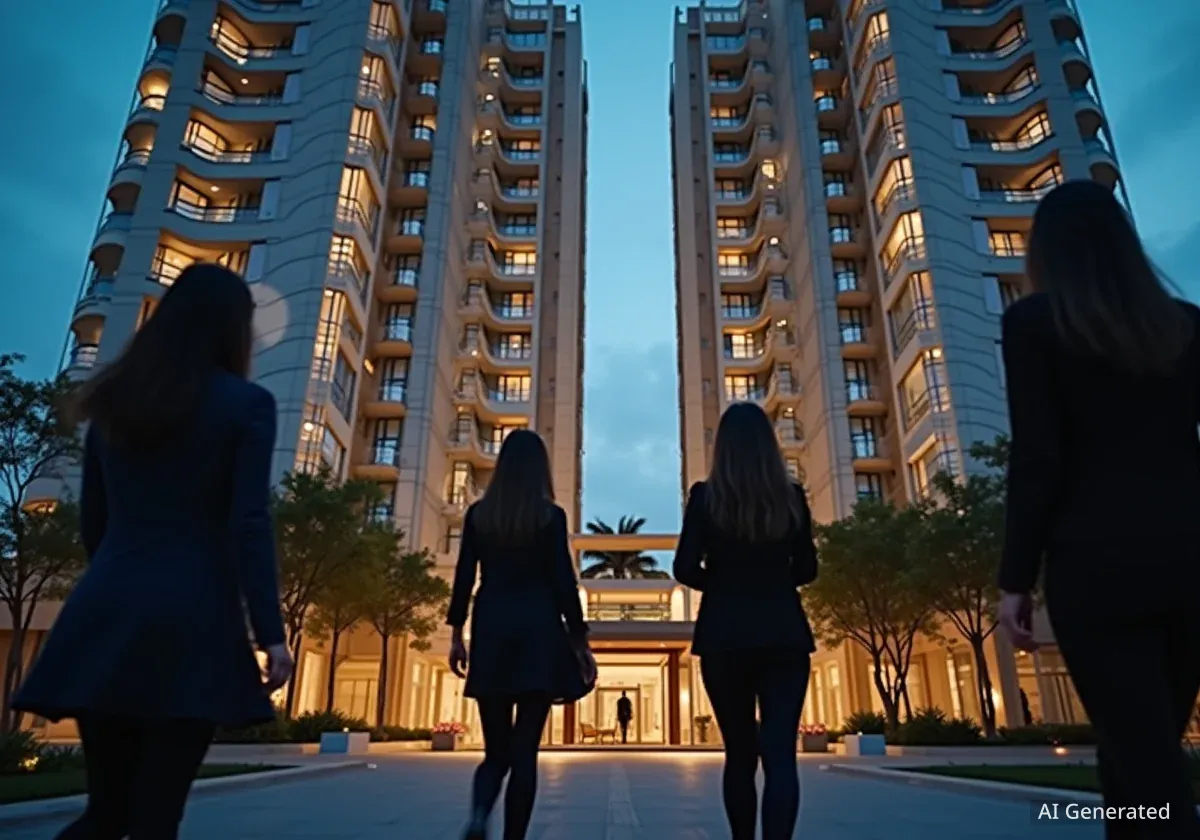India's real estate sector, historically dominated by men, is experiencing a significant transformation. A new generation of women leaders is now at the forefront of capital-intensive and innovative ventures, particularly within Mumbai's competitive ultra-luxury market. They are influencing every stage of development, from financial structuring and land acquisition to urban design and construction management.
This change is not merely about representation; it is a structural evolution driven by new leadership styles, a focus on sustainability, and a deeper understanding of modern consumer demands. This shift is reshaping both the skylines of major cities and the underlying business metrics of the industry.
Key Takeaways
- Women are increasingly leading high-stakes ventures in India's real estate sector, especially in Mumbai's luxury segment.
- Companies led by women in the industry report up to 21% higher profitability and improved project completion rates.
- The number of female homebuyers in India's major cities has risen to 30-35% of the market.
- Government policies, such as stamp duty concessions for women, are accelerating the trend of female property ownership.
- Women-led projects are often pioneers in sustainability and wellness-focused architectural design.
A Structural Shift in a Male-Dominated Industry
The Indian real estate market is undergoing a fundamental change in its leadership structure. Women are moving into key executive roles, shaping high-level decisions that were once almost exclusively made by men. This is particularly evident in the high-stakes environment of Mumbai's ultra-luxury property development.
Leaders in this new wave are not just participating; they are directing core strategies. Their work involves identifying undervalued land parcels, reimagining urban neighborhoods, and forging partnerships with global firms to deliver high-margin, forward-thinking residential properties.
Prominent Leaders in the Sector
A dynamic group of female developers is redefining how ultra-luxury real estate is conceptualized and delivered. Notable figures include Sanya Runwal of Runwal Realty, Manju Yagnik of Nahar Group, Pia Singh of DLF, and Shraddha Kedia Agarwal of Transcon Developers. Their projects often reflect a sophisticated understanding of consumer expectations and a long-term vision for urban architectural evolution.
These leaders are changing the conversation around luxury living. Their approach considers what modern luxury should represent, the values it must embody, and how it can provide lasting intergenerational value. This extends beyond simple construction to encompass cultural relevance and community building.
Measurable Impact on Business Performance
The rise of female leadership in real estate is backed by compelling business results. Recent industry data indicates that firms led by women are demonstrating superior performance across several key metrics. This suggests that inclusive leadership is not just a social goal but a strategic business advantage.
Data-Driven Success
According to industry reports, real estate companies with women in leadership positions have been found to achieve up to 21% higher profitability. These firms also report stronger customer engagement and higher on-time project completion rates, which are critical factors in a capital-intensive industry.
These positive outcomes are often attributed to a more inclusive and customer-centric approach to planning. In Mumbai's complex redevelopment ecosystem, which involves intricate negotiations, regulatory hurdles, and stakeholder management, women often bring a consensus-driven leadership style. This emphasis on trust, clarity, and meticulous attention to detail can lead to more stable and successful project outcomes, especially for long-term developments in high-value areas.
Pioneering Sustainability and Innovative Design
Sustainability is a core focus for many women-led real estate firms. These companies are integrating environmental performance as a fundamental aspect of design rather than treating it as a mere compliance requirement. This commitment is visible in the advanced features of their projects.
Examples of this focus include:
- Climate-responsive building facades that improve energy efficiency.
- Advanced Mechanical, Electrical, and Plumbing (MEP) systems designed to conserve resources.
- Integrated electric vehicle (EV) charging infrastructure.
- Pursuit of green building certifications like LEED or IGBC.
Beyond sustainability, these leaders are redefining the concept of luxury architecture. There is a strong emphasis on the spatial experience, focusing on elements like proportion, privacy, and seamless integration with nature. Contemporary projects increasingly feature expansive private decks, triple-height entrance lobbies, and wellness-centric amenities. The incorporation of curated art and biophilic design reflects a philosophy that prioritizes both elegance and intentional living.
"The new generation of developers is reshaping the conversation around who luxury is designed for, what values it must embody, and how it should mature over time."
Execution is managed with equal rigor. Women leaders are demonstrating strong operational command, overseeing everything from complex land clearances to collaborations with international design and engineering consultants. Many are also structuring sophisticated capital partnerships and joint development agreements to mitigate risk and ensure brand longevity.
The Rise of the Female Homebuyer
The transformation in the real estate sector is not limited to corporate boardrooms; it is also reflected in consumer behavior. There has been a significant increase in the number of women purchasing property in India's major metropolitan markets.
Data shows that women now account for 30% to 35% of all property buyers in the country's top cities, a sharp increase from previous decades. This trend is visible across all market segments, including the ultra-luxury category. High-profile transactions underscore this shift.
Notable High-Value Purchases
Recent major property deals highlight the growing purchasing power of women. Tanya Dubash of the Godrej Group recently acquired a sea-facing duplex in Worli for ₹226 crore. In the same area, Leena Gandhi Tewari of USV Pharmaceuticals completed a transaction for two ultra-luxury residences valued at ₹703 crore.
Government policy has played a role in encouraging this trend. Several Indian states offer financial incentives for women who register property in their names. In Maharashtra, for example, a woman registering a home receives a 1% concession on the stamp duty. On a multi-crore luxury property, this translates into savings of several lakhs, creating a direct financial incentive for high-net-worth women to invest in real estate and hold titles directly.
This policy not only empowers women financially but also contributes to a fundamental shift in property ownership patterns at the highest levels of the market. The combined effect of female leadership in development and growing purchasing power among female buyers is creating a more balanced and dynamic real estate ecosystem in India.





